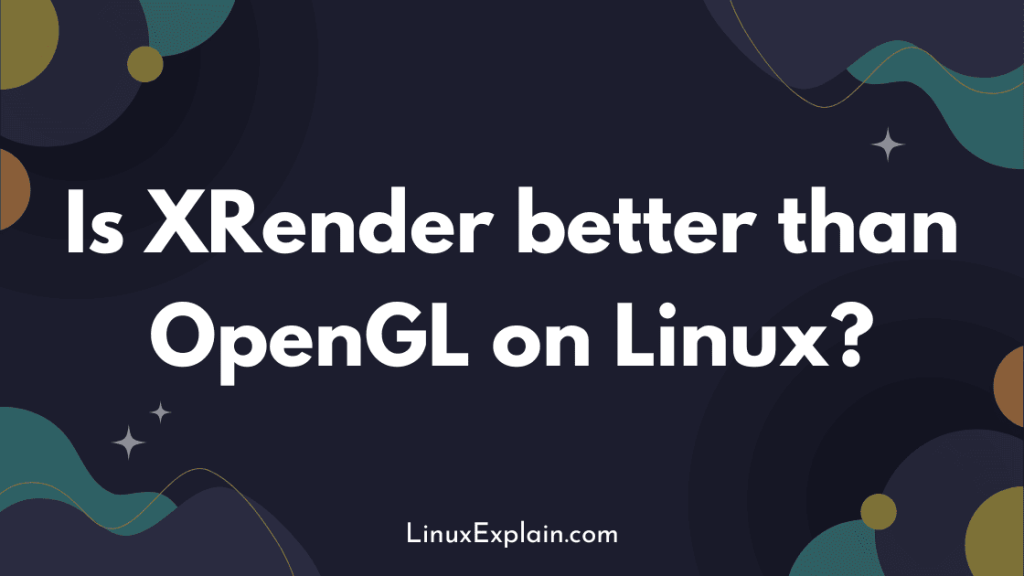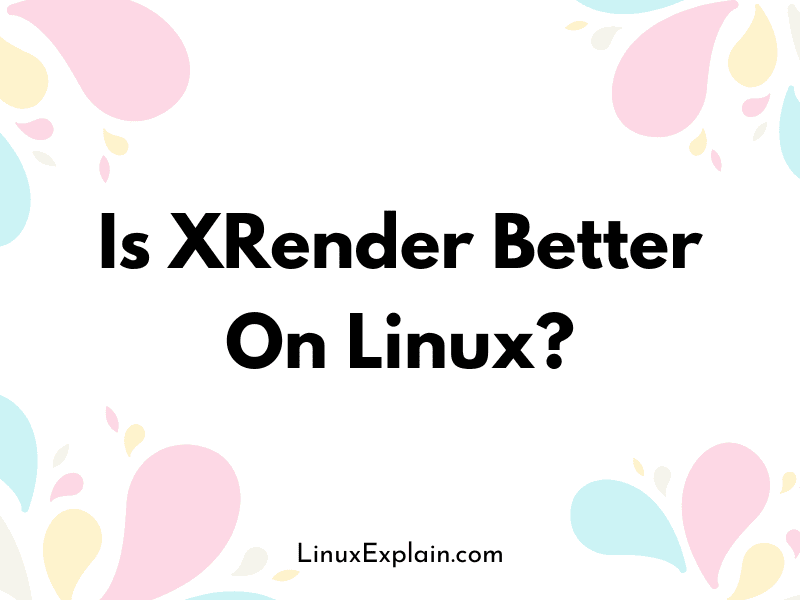Some users believe that XRender is better optimized for use on Linux than on other platforms, such as Windows.
What is XRender?
If you’re looking to improve the look and feel of your website or blog, XRender GPU may be a good investment. This graphics processing unit is ideal for rendering 3D scenes in real-time, which results in better graphics quality and a more immersive experience for your visitors.
It’s used by video game developers and designers to create high-quality graphics for their products, so you can be sure that it offers tremendous performance when it comes to graphics. If you’re unsure whether or not an XRender GPU is right for your project, don’t hesitate to contact us for more information.
Is XRender worth using on Linux?

Linux is a great platform for graphics and gaming enthusiasts, as it offers a high level of flexibility and performance. XRender is a great 3D rendering engine that can be used on Linux to create high-quality graphics. It offers many benefits, including performance and flexibility.
Plus, it’s easy to install and use, so you can get started quickly. If you’re looking for an advanced 3D rendering engine, XRender is a good option to consider!
What are the pros and cons of XRender?
When it comes to 3D rendering, there are a variety of programs available on the market. Each has its pros and cons, depending on your needs. If you’re looking for an advanced program with lots of flexibility and speed, XRender may be a good option for you.
On the other hand, if you’re on a budget and want something affordable and easy to use, another program like Maya or Blender may be a better fit.
Additionally, it’s worth noting that there is no one perfect 3D rendering software – each has its own unique set of features and benefits that you may find useful.
Ultimately, the decision of which 3D rendering program to choose is up to you.
Is XRender better than OpenGL on Linux?

It can be tough choosing the right graphics API for your projects. While both OpenGL and XRender have their strengths and weaknesses, it may be best to explore both options before making a decision.
The benefits of using XRender
If you’re wondering if XRender is better than OpenGL on Linux, the answer is a resounding yes! Xrender is a more optimized rendering engine that offers faster performance and reduced GPU usage. This makes it an ideal choice for gaming and 3D applications, while also allowing you to create high-quality graphics without having to learn OpenGL.
So if you’re looking for an engine that’s better suited for your specific needs, then Xrender is a perfect choice!
The drawbacks of using OpenGL on Linux
There are two main graphics engines available on Linux – XRender and OpenGL. While XRender is more efficient and faster in most cases, there are circumstances where OpenGL will perform better.
One of the main drawbacks of using OpenGL on Linux is that it is not as powerful as XRender. However, with the right hardware setup, OpenGL can still be a viable option for graphics-intensive applications.
Ultimately, it comes down to what you need your application to do – if it requires high-end graphics capabilities, then use XRender; if not, then go with OpenGL.
Why XRender is better?
Now that you know a little bit about XRender and OpenGL, it’s time to decide which one is better for your needs. XRender uses modern graphics libraries that are faster and more efficient than OpenGL. This means that XRender can take advantage of hardware acceleration on some platforms which gives better performance.
Furthermore, XRender is open source, so you can easily modify or improve it if needed. So, in the end, XRender might be the best graphics library for you if you’re looking for a fast and efficient solution with good hardware support.
XRender or OpenGL?
When it comes to graphics, many users are divided into two camps: those who swear by XRender and those who swear by OpenGL. So, which is better? The answer is that it depends on your use case. If you are using an older computer, then OpenGL will be faster.
However, more recent computers tend to favor XRender because its performance has improved in recent years. There is a lot of debate between the two when it comes to performance; however, in the end, what matters is how well each suits your own needs.
Ultimately, it depends on what graphics applications you are using and so on.
What are the main advantages of using XRender on Linux?
Linux offers a wide range of advantages when it comes to using XRender, including compatibility with many hardware devices and software applications.
Plus, it’s also possible to create high-quality renders very quickly using XRender on Linux. Finally, thanks to the open-source nature of XRender, there are numerous third-party tools and libraries available that can be integrated into your workflow easily.
So, if you’re looking to take your graphics rendering to the next level, give Linux a go!
Are there any disadvantages to using XRender on Linux?
There are plenty of reasons to use XRender on Linux – from its powerful rendering capabilities to its compatibility with various graphics cards.
However, there are also a few potential disadvantages to be aware of.
Firstly, performance may not be as good as when using native rendering software. However, overall the benefits of using XRender on Linux vastly outweigh any drawbacks.
Secondly, finding compatible software can be difficult, but this is generally a minor inconvenience.
Last but not least, one potential disadvantage is that it can be more difficult to find software compatible with X Render on Linux than on other platforms. So, if you’re looking to take your graphic design to the next level, don’t hesitate to give X Render a try on Linux.
Are there any better graphics drivers for Linux?
Graphics drivers on Linux can be hit and miss. While they offer some advantages, such as compatibility with newer hardware and faster installation times, they often have shortcomings.
In the end, it comes down to a personal preference as to whether or not to use open-source graphics drivers. If you’re willing to experiment with different options, custom driver builds may be your best bet for optimal gaming or video experience on Linux.
However, make sure that you know what you’re getting yourself into – some driver builds can be incredibly unstable and cause all sorts of headaches.
An unbiased comparison of XRender on Linux and Windows
If you’re looking for a powerful 3D graphics engine that can be used for a variety of applications, be sure to check out XRender. It’s available on both Linux and Windows platforms, making it a great choice for anyone who wants versatility when it comes to their software choices.
Additionally, this engine is incredibly versatile and can be used to create stunning visuals for games, web browsers, and other applications. As an unbiased comparison of the two platforms, be sure to check out this article!
Why would you want to use it on your project?
If you’re looking for a high-end 3D rendering engine that offers several benefits for your project, then you should consider using XRender. This open-source engine is known for its fast and efficient performance, making it the perfect choice for high-profile or time-sensitive projects.
Furthermore, XRender is cross-platform, so you can use it on Linux or Windows machines without any concerns. Plus, there are no licensing fees associated with it, so you can modify or improve it as you see fit.
So if you’re searching for a powerful and reliable 3D rendering engine that will give your project the quality it needs to stand out from the crowd, then X Render is the perfect option!
How do the two compare in terms of performance and features?
If you’re looking for powerful 3D rendering software that is compatible with both Linux and Windows, then XRender is the perfect option for you.
On Linux, the software performs well but requires some tweaking to get optimal performance. However, once configured correctly, users find the software to be very efficient and reliable.
Windows users also find the software more straightforward to use, with more features available than on Linux. Whilst XRender is a powerful 3D rendering software, its user interface may not be as intuitive for those who are new to 3D rendering software.
Are there any benefits to using XRender on Linux over Windows?
If you’re looking for a powerful graphics rendering engine that can be used to create stunning visuals for your website or application, then you should consider using XRender on Linux. While there are some advantages to using XRender on Linux over Windows, there are also several disadvantages.
Ultimately, the decision whether to use XRender on Linux or Windows depends on your specific needs and requirements. In addition, it is available on both Windows and Linux, making it an ideal choice for cross-platform development.
How to use XRender on Linux?
Linux has come a long way in the graphics department, and the XRender-driver package is a testament to that. This powerful 3D rendering engine is free and open-source, so you can use it to create stunning graphics. Once installed, launch the XRender window by entering “XRender” in your terminal emulator of choice.
XRender is a powerful 3D rendering engine that can be used on Linux. It’s free and open-source, so you can use it to create stunning graphics. To get started, install the XRender-driver package using your favorite software installer.
Why is XRender better than other rendering engines on Linux?

Rendering engines are essential for creating high-quality graphics for websites and desktop applications. Choosing the right one can be tricky, but XRender is a great option for Linux users. It’s optimized for the platform and includes features like per-pixel shading and programmable shaders, which give you more control over your images.
Additionally, it supports a wide range of graphics cards and has an easy-to-use GUI. So, if you’re looking for the best possible performance on your Linux system, choose XRender!
Is XRender better than other rendering engines on Linux?
If you’re looking for a powerful and reliable rendering engine for your Linux system, then XRender is a perfect choice! It offers great performance and stability, making it the ideal choice for high-end graphics applications.
Additionally, it’s also open-source, so you can customize and improve its functionality as needed. So why wait? Get started today and see for yourself how XRender can improve your graphics workflow!
XRender compositing faster than OpenGL?
There have been a lot of talks lately about which rendering engine is faster – XRender or OpenGL. While the answer to this question is subjective, there are some definite benefits to using XRender.
Here are four reasons why you should switch to using XRender for your next project:
- Efficiency – Because X Render uses less memory and CPU resources than OpenGL, it’s ideal for use in high-performance applications such as gaming and animation.
- Cross-platform Support – Both engines support a wide range of hardware configurations, so switching will not have any negative impacts on your current software portfolio.
- Speed – X Render can render scenes much faster than OpenGL, so it’s perfect for tasks like real-time 3D graphics and video processing.
- Compatibility – Since both engines support a wide range of hardware configurations, switching will not have any negative impacts on your current software portfolio.
How do I enable/disable Xrender in Cinnamon?
Enabling or disabling Xrender in Cinnamon can improve the performance of your desktop environment. To do this, you’ll need to open the preferences file and find the “Display” section. There, you’ll need to change the value of “XRender” to either “On” or “Off.” Once you’ve made the changes, restart Cinnamon for them to take effect. If you’d like to enable or disable Xrender globally for all users of your desktop, you’ll need to open the preferences file as root and find the “System Settings” section. There, you’ll need to change the value of “XRender” to either “On” or “Off.”
Frequently Asked Questions
What are the best XRender extensions?
The best XRender extensions can be found at xrender.org.
Is XRender faster than other rendering engines?
Different rendering engines perform differently based on the scene being rendered and the specific hardware being used. However, a study by ray-tracing software developer Marmoset showed that XRender was 25-40 percent faster than other popular rendering engines such as Nvidia’s next and AMDs GPU.
What are the benefits of using XRender?
There are many benefits of using XRender for graphics rendering, including high performance and precise image quality. The source of information for this question is the Xrender website.
What are the downsides of XRender?
There are a few downsides to XRender. One of the potential disadvantages is that XRender might not be able to handle high-resolution graphics or large file sizes.
How can I use XRender on my Linux system?

The best way to use XRender depends on the specific hardware and software configuration of your Linux system.
However, some general tips that may help include reading the documentation available from the XRender project website or consulting a knowledgeable online forum or the technical support forum.
Is XRender better than OpenGL on Linux?
OpenGL is the default graphics library on many Linux distributions, while XRender is an open-source implementation of the OpenGL standard.
What are the drawbacks of using XRender?
There are potential drawbacks to using XRender for graphics rendering. One potential issue is that XRender is a proprietary engine, so it may not be available on all platforms.
Additionally, XRender can use a lot of resources, so it may not be appropriate for use in high-performance settings.
Can I use XRender with Wine?
Wine is not a graphics card.
Is XRender faster than OpenGL?
Xrender is faster than OpenGL on many modern desktop and laptop GPUs. However, XRender may be slower on some older GPUs.
How do I enable XRender in Linux?
There is no officially supported way to enable XRender in Linux, but there are various unofficial methods that can be used. Some of the more popular methods include installing the XRender-devel package, using the XRender-generate configuration file, or using the XRender utility.
What are the requirements for using XRender?
There are no specific requirements for using XRender. However, to get the best results, XRender should be used in conjunction with a graphics card that supports its rendering capabilities.
What are the benefits of using XRender?
The benefits of using XRender include higher frame rates, reduced file size, and faster rendering times. The source of information for these facts and figures is the Xrender website.
Is XRender faster than OpenGL?
Both XRender and OpenGL are rendering engines with their strengths and weaknesses. Some factors that could influence how fast a particular implementation of the graphics API is may be the hardware configuration used, the complexity of the rendering task being performed, and the programming language used to create the application.
Which graphics cards are best suited for using XRender?
Nvidia GeForce GTX 1070 and 1070 Ti are the best graphics cards for using XRender.
Is XRender faster than other open-source rendering engines?
Which rendering engine is faster, as this depends on the specific task at hand. However, some popular open-source rendering engines include XRender and OpenGL.
Is XRender suitable for 3D rendering applications?
XRender is not generally recommended for 3D rendering applications.
Which Linux distribution is best suited for using XRender?
However, some of the more popular distributions that are known to work well with XRender include Ubuntu, CentOS, and Fedora.
What are the benefits of using XRender over other rendering engines?
There are many benefits to using XRender over other rendering engines, such as speed, image quality, and cross-platform compatibility.
Why is the Linux interface very difficult to understand?
The Linux interface is very difficult to understand because it was designed to be user-friendly.
Is XRender better than OpenGL?
Different developers may prefer different rendering engines for different applications or games.
Which rendering backend I should use?
The answer to this question depends on the specific needs of the project. There are many different rendering backends available, each with its advantages and disadvantages. Some common rendering backends include:
- Houdini: well known for providing high-quality 3D renderings, Houdini can be expensive to purchase outright but has a wide range of features and is popular among professional graphic designers and animators.
- Maya: one of the most popular 3D animation software packages in the world, Maya is versatile and can be used for a variety of 3D tasks from character animation to realistic landscapes.
- Blender: Used by artists and filmmakers for creating 3D models, environments, and animations, Blender is free to use and open source.
Which Linux distro is best for XRender?
The answer to this question depends on your needs. Some distros are better for graphics-intensive tasks such as producing 3D graphics, while others may be better for more general use cases such as desktop productivity or servers. It is best to consult a Linux expert for their recommendations.
How do I install XRender on Fedora?
If installing xrender-devel is not an option for you, two RPMs can be installed from the Fedora repositories: xrender-devel or libXrender. xrender-devel is a higher level dependency and should only be needed in some rare cases, while libXrender is more commonly used. Both RPMs can be installed with yum.
What are the differences between XRender and OpenGL ES 2D?
XRender is an OpenGL-based rendering API that is used in mobile and desktop applications. OpenGL ES 2D is a subset of OpenGL that is optimized for 2D graphics.
Is there a way to get the latest version of XRender in Debian?
Xrender can be installed with the XRender-utils package.

